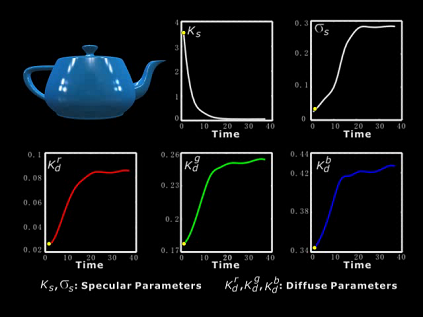Database OrganizationThe release of the database includes 2 parts for each scanned sample: the raw measurements, and the fitted BRDF parameters. The TVBRDF database consists of a total of 41 samples each of which is denoted by a unique sample ID. The structure of the database, for sample01, is as follows:
Database DetailsThe following is a detailed description of all the data released:
1) Sample Name (Process)
2) Exposures used to generate HDR radiance data
3) Number of scans
4) Time stamp of each scan
where TT is the scan index (from 01 to the number of time this sample was scanned), V is the camera index (from 1 to 4, see here for an explanation of the rig). There are thus number of views (4) X number of scans (sample specific) files in this folder and each file stores the BRDF for all lighting directions. The first line of each file lists the exposures used for the sample. Each set of three lines following this has the radiance values (B G R), the lighting direction (LX LY LZ) and the viewing direction (VX VY VZ). For example for sample01 scan01_brdf_camera1_allexposures.txt looks like Exposure 0.200000 4.000000 32.000000This means that the radiance for this sample at lighting direction <0.978148, 0.000000, 0.207912> and viewing direction <-0.207912, 0.000000, 0.978148> the radiance is (0.834711, 0.778409, 0.669680). These measurements need to be radiometrically calibrated to compensate for both the light source and the camera response. For this we used a spectralon sample with albedo(B, G, R) = (0.7410, 0.7438, 0.752). The radiance measurements for the spectralon sample are here. We fit a Lambertian BRDF model to the radiance measurements of the spectralon and have computed the normalization constants for each camera and each color channel. These can be accessed here. The four lines of this text file have the values (B, G, R) that the radiance measurements from each camera need to be divided by for each color channel. Each line of this file has fit parameters for one scan. For the paint, drying and miscellaneous samples (sample01 - sample27 and sample40 - sample41) we have fit a combination of the Oren-Nayar diffuse BRDF and the Torrance-Sparrow specular BRDF models. For these samples brdf-params.txt has 6 parameters at each time instant. These are, in order K_d(B, G, R), sigma_d, K_s and 1 / sigma_s, For the dust samples (sample28 - sample39) we have fit a combination of Blinn's Dust BRDF and the Torrance-Sparrow specular BRDF models. For these samples brdf-params.txt has 11 parameters at each time instant. These are, in order K_d(B, G, R), sigma_d, K_s, 1 / sigma_s, w_dust(B, G, R), g and tau For a detailed explanation of each model and parameter please look at the following paper and its appendices: The fitted model enables us to directly render the measured materials' appearance over time. The following video shows a teapot rendered with our measurements of the BRDF of blue watercolor on white paper. Note the change in the fit model parameters over time and the resulting change in the appearance. |
||||||||||||||||
|
TVBRDF Database Home Contact: tvbrdf@cs.columbia.edu Last modified: 06/03/2007 |
